Grower reveals yield and margin data from intercropping trial
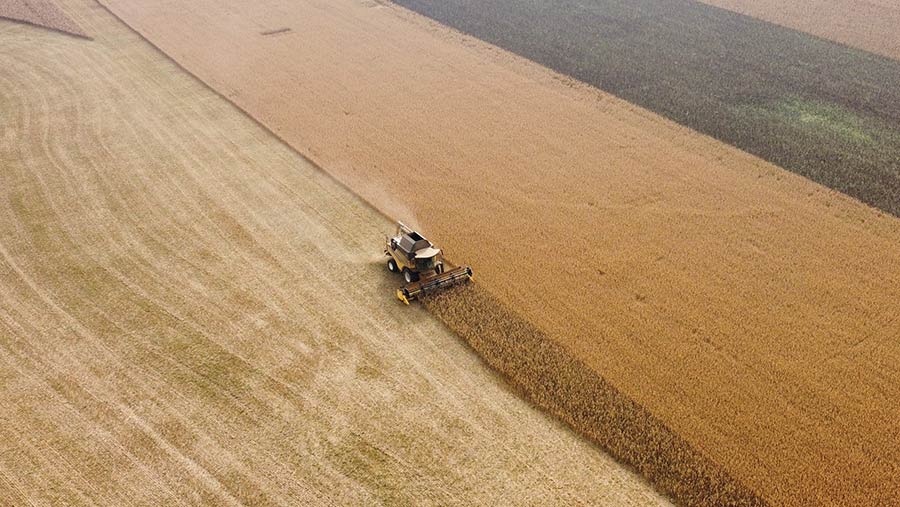 © Ben Adams
© Ben Adams A mix of peas and mustard generated the highest gross margin in the first year of an extensive intercropping trial carried out by Oxfordshire farmer Ben Adams, where different crop mixes were assessed for yield, quality and ease of harvest.
Nine different combinations of peas, beans, vetch, oilseed rape, mustard, oats and barley were successfully harvested across 16ha, with zero inputs applied.
After crunching the numbers, Ben found the winning peas and mustard combination generated a gross margin of £1,036/ha.
See also: How intercropping trial aims to eliminate chemical inputs
He recalls that crops were drilled a good two weeks later than optimum on 18 and 19 April due to wet spring conditions, with yields consequently lower than expected, particularly spring beans.
“Intercropping certainly has a place as a break crop on the farm. The peas and mustard mix stood out the most, which I am definitely keen to scale up,” says Ben.
The results
Ben revealed the establishment, yield and financial figures for each crop combination, after winning a net zero food and farming competition to fund the three-year trial at Lower Farm, near Bicester.
He notes that although growing a cereal with a legume can affect yield, it successfully suppresses weeds.
When intercropping, he recommends growing the mix with the mindset of keeping one crop as the main, with any additional species acting as a companion and if it yields at harvest this is a bonus.
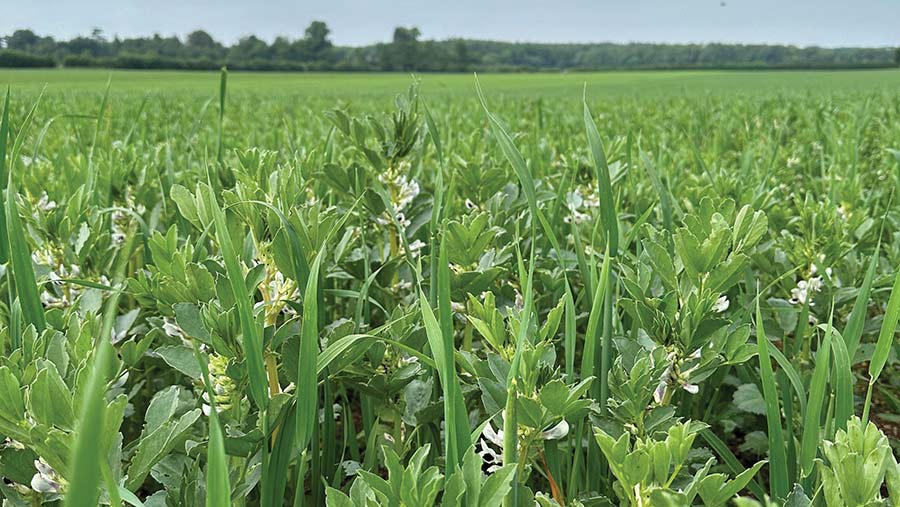
Beans and oats © Ben Adams
Beans 250kg/ha + oats at 35kg/ha + OSR at 5kg/ha
Ben had high hopes for this three-way mix, but the beans and oats suffered from the late drilling, while the spring oilseed rape was significantly later to mature.
“The OSR turned out to be a disaster as it began flowering again in late July.”
Beans at 280kg/ha + OSR at 6kg/ha
Throughout the establishment phase, the crops looked promising but it became prone to weed attack and a lot of thistles developed. Again, the OSR was late to mature.
Oats at 130kg/ha + vetch at 6kg/ha
Unfortunately, an issue with the calibration on the Horsch Avatar meant the seed rate was not drilled thick enough.
“The vetch was earlier to mature than the oats so I think this would be more suited to growing with barley,” says Ben.
The plot harvested with ease with a clean disease-free sample.
Beans at 280kg/ha + oats at 40kg/ha
This classic intercropping favourite often known as “boats” performed well, with crops looking green and healthy with plenty of colour.
The beans were free from rust and chocolate spot and it wasn’t until the oats began to senesce that disease began to develop.
Overall, it performed well with an overall gross margin of £398/ha (in comparison with Ben’s conventionally grown monocrop of beans generating a gross margin of £328/ha).
However, the plot was established across part of the headland so it suffered a yield penalty.
Barley at 150kg/ha + vetch at 6kg/ha
Similar to the oats and vetch plot, the vetch should have been drilled at a higher rate.
Barley tends to suffer if it doesn’t have early nitrogen and as a result, the crop was stressed as no nitrogen applications were made, which limited its yield to 2.22t/ha.
Peas at 250kg/ha + OSR at 6kg/ha
The peas performed surprisingly well at 3.35t/ha. The oilseed rape looked much more promising than it did when grown with the beans, with bigger bolder canopies.
“However, as the peas developed they began to outcompete the OSR and overshaded the crop as they grew to 4ft tall.”
Growth fell behind and it wasn’t until early August when the peas started to lie down, the rapeseed managed to break through the canopy and get going.
“The oilseed rape matured a lot later which proved difficult at harvest as we needed to crack on with the peas as they were falling out of their pods, but the rapeseed was flowering.
“I was not a fan of the spring oilseed rape in any of the plots and am not growing it next year,” says Ben.
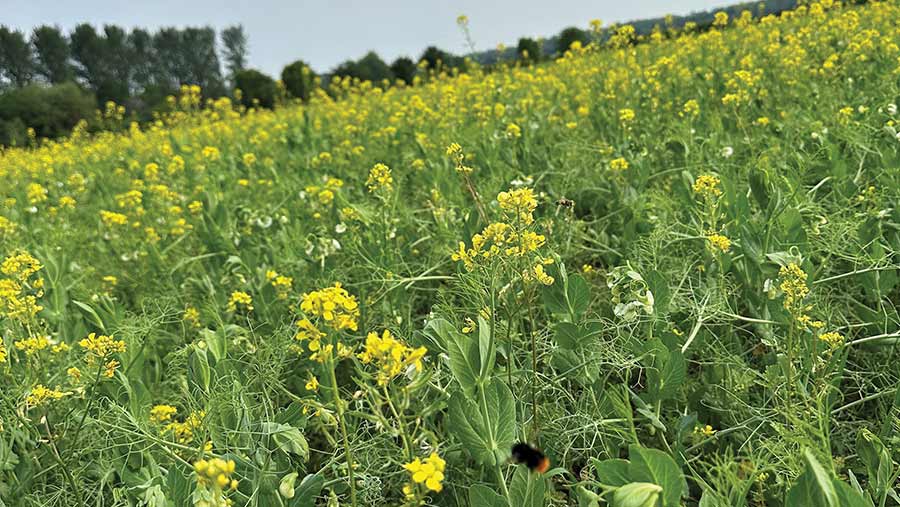
Peas and mustard © Ben Adams
Peas at 220kg/ha + barley at 30kg/ha + mustard at 4kg/ha
This plot established well, with good green cover and “beautiful looking crops”.
Despite a relatively low seed of barley at 30kg/ha, there was noticeably reduced weed pressure compared with the pea and mustard intercrop.
Peas did not yield as well as a result of the competition from barley, but still a decent combined output.
Peas at 250kg/ha + mustard at 6kg/ha
“This was a beautiful looking plot with an array of beneficial insects. I don’t know why, but mustard just seems to flower for months. This was probably my favourite plot.
“The mustard did really well and acted as a scaffold holding the peas up. It did suffer from a bit more weed pressure than when barley was in the mix.
“This is something I’m definitely going to continue into the future as it looked brilliant and yielded well with the highest gross margin.”
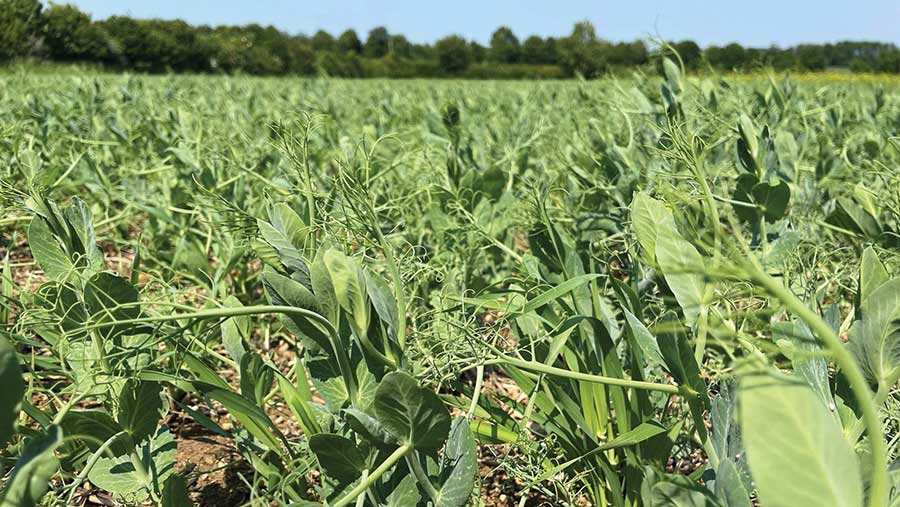
Peas and barley © Ben Adams
Peas at 250kg/ha + barley at 40kg/ha
The barley suffered from the lack of nitrogen, but picked up towards the end of the season when Ben suspects there was some nitrogen sharing between the peas.
Of all the pea plots, the peas in the barley mix yielded their lowest at 1.7t/ha, but Ben notes this was established on the headland which affected results.
Financial performance of different crop combinations at Lower Farm |
||||||
|
Crop |
Variable costs (£/ha) |
Yield (t/ha) |
Total yield (t/ha) |
Price (£/t) |
Combined output (£/ha) |
Gross margin (£/ha) |
|
Beans Oats OSR |
256 |
1.39 1.53 0.02 |
2.94 |
235 200 300 |
662 |
405 |
|
Beans OSR |
272 |
1.89 0.09 |
1.98 |
235 300 |
499 |
228 |
|
Vetch Oats |
111 |
0.17 2.40 |
2.57 |
1,500 200 |
729 |
618 |
|
Beans Oats |
204 |
1.42 1.23 |
2.65 |
235 200 |
602 |
398 |
|
Vetch Barley |
130 |
0.19 2.22 |
2.41 |
1,500 220 |
767 |
636 |
|
Peas OSR |
244 |
3.35 0.11 |
3.46 |
345 300 |
1,186 |
942 |
|
Peas Barley Mustard |
372 |
2.15 0.57 0.19 |
2.91 |
345 220 1,700 |
1,182 |
810 |
|
Peas Mustard |
181 |
2.15 0.28 |
2.43 |
345 1,700 |
1,217 |
1,036 |
|
Peas Barley |
180 |
1.70 0.82 |
2.52 |
345 220 |
768 |
588 |
Market
After harvest, the mixes were run through the farm’s three-screen rotary sieve cleaner to separate the seed.
“It took 36 hours to separate a total of 37t of various intercrops. This worked out to cost £45/ha at a rate of £20/hour for both man and machine,” says Ben.
“We were altering the sieves for a small amount of different crop combinations.
“If you’re doing an entire field of one intercrop, this would be less timely and costly,” he adds.
All harvested crops were either sold as cash crops or kept as farm-saved seed.
Vetch and mustard were kept as cover crop seed and given a cost price of half the standard price of cover seed, for fair comparison.
Barley and vetch were kept as next year’s farm saved seed to qualify for the SFI companion cropping payment, which pays £55/ha.
Peas and mustard will also be kept for next year’s legume fallow payment with the addition of four types of clovers as this requires six species of flowering crops for payment of £593/ha.
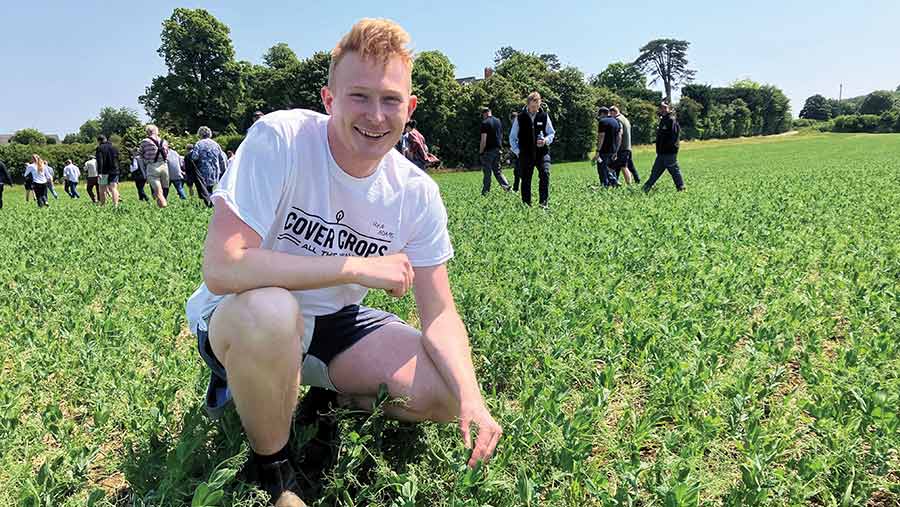
Ben Adams © MAG/Emma Gillbard
Next steps
Ben has since planted a winter wheat variety blend and is keen to assess the effects on tillering, establishment, yield and quality on the following winter wheat crop, before establishing another round of intercrop trials.
Industry partners for the net zero food and farming trial include: Morrisons, McDonald’s, Trinity Ag Tech, Trinity Global Farm Pioneers and Bradford Estates.
Potential SFI payments
The intercropping trials are compatible with a number of current Sustainable Farming Incentive payments which total £235/ha.
This includes companion cropping at £55/ha, no-insecticide at £45/ha, winter cover crop at £129/ha and a soil assessment at £6/ha.

